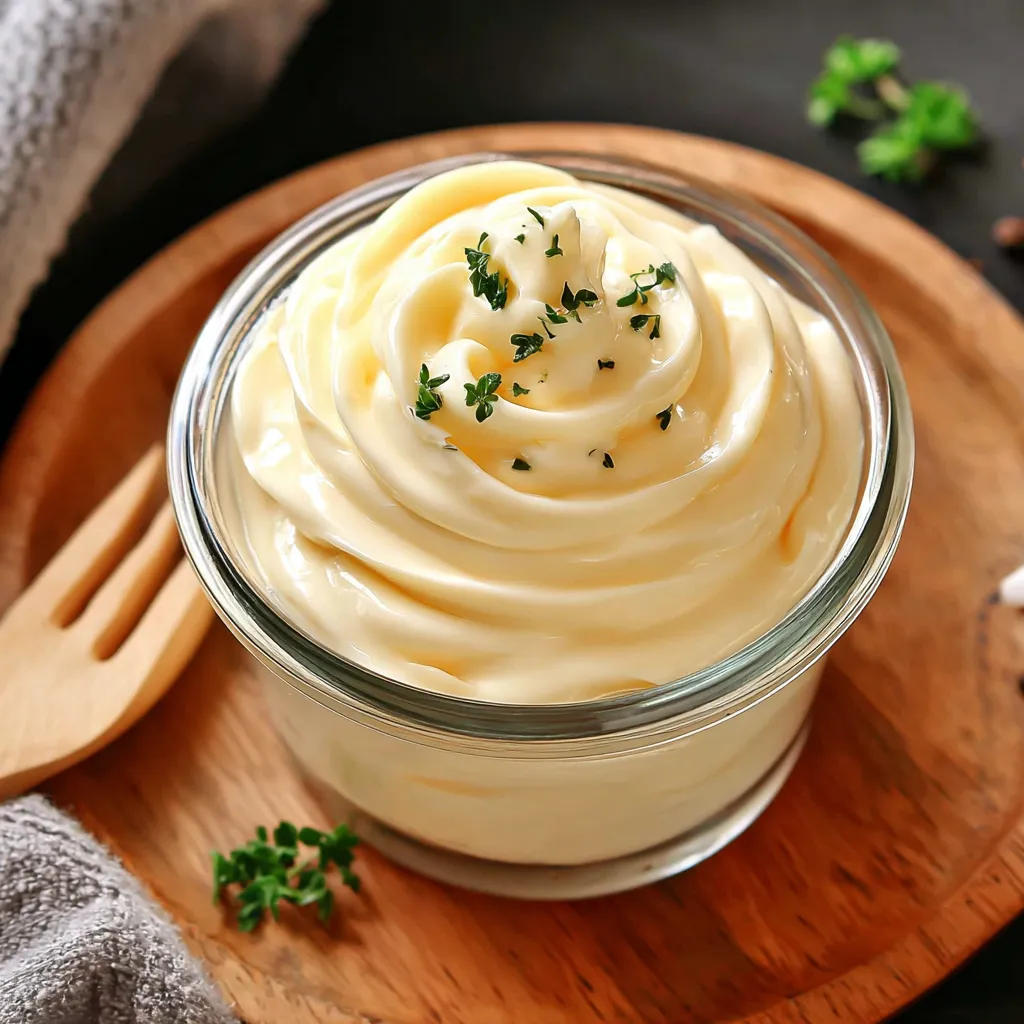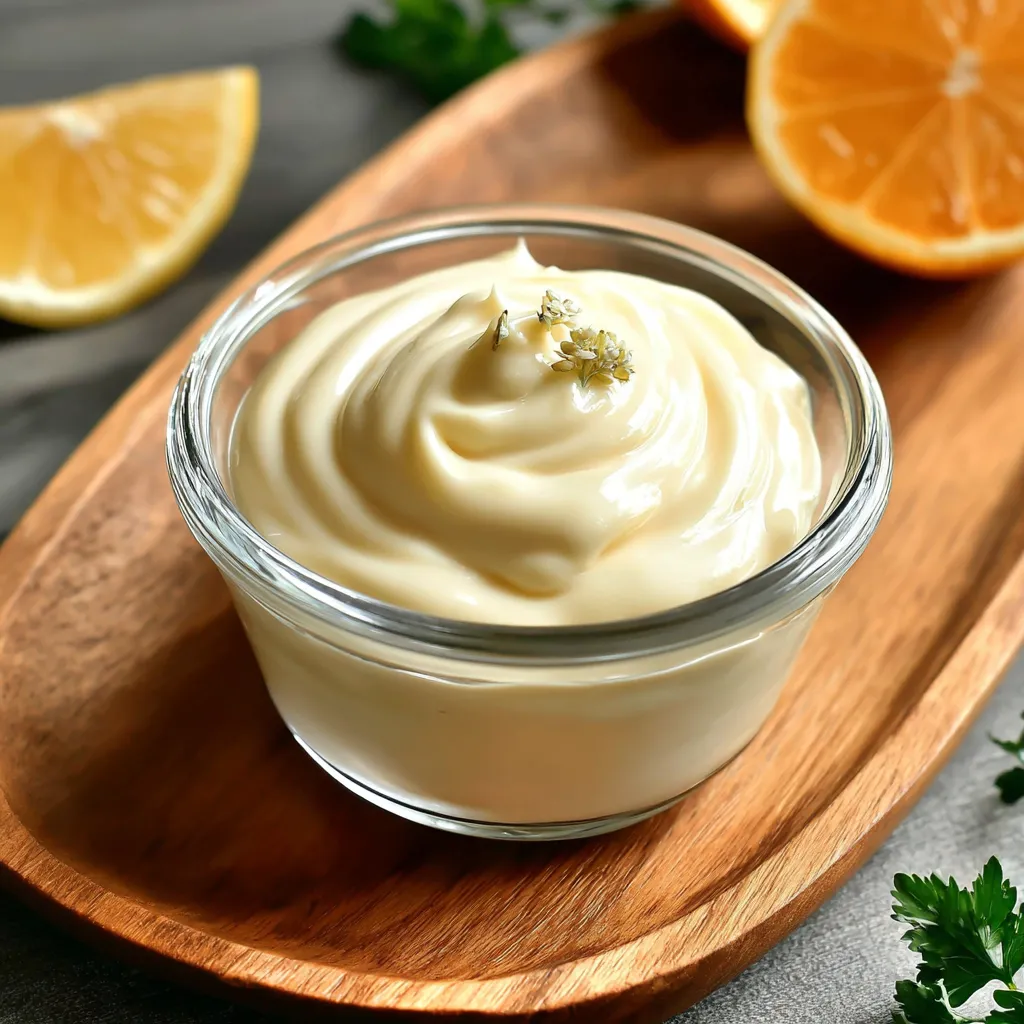 Save
Save
This homemade mayonnaise transforms everyday ingredients into a silky, rich condiment that makes store-bought versions pale in comparison. After years of relying on jarred mayo, I discovered that making it from scratch elevates everything from sandwiches to salad dressings with its pure, fresh flavor.
I first made this recipe when I ran out of mayonnaise for a family gathering. What started as a kitchen emergency has become a weekend ritual my daughter now helps with, claiming she can taste the difference in our tuna salad.
Ingredients
- Fresh large egg provides the essential emulsifier for proper texture
- Salt enhances flavors and helps preserve the mayonnaise
- Fresh lemon juice adds brightness and helps with preservation
- Avocado or olive oil forms the base use light olive oil for milder flavor
- Optional garlic juice adds subtle depth without overpowering chunks
Step-by-Step Instructions
- Process the base
- Add egg, salt, lemon juice and optional garlic juice to your food processor. Process for a full 30 seconds to thoroughly combine and begin the emulsion process. The mixture should look slightly frothy and pale yellow.
- Add oil with precision
- With the processor running, begin adding oil in an extremely slow, steady stream through the feed tube. This should take about 1.5 minutes for the full cup. The slow addition is crucial for proper emulsification and will prevent breaking. Watch as the mixture transforms from liquid to a creamy, thick consistency.
- Final processing
- Stop the machine, scrape down any oil clinging to the sides with a spatula, and process for an additional 30 seconds. This ensures complete incorporation and maximum thickness. The mayonnaise should now cling to a spoon when lifted.
- Rest and develop
- Transfer to a clean container with a tight fitting lid and refrigerate for at least 4 hours. This resting period allows flavors to meld together and the texture to further thicken into that perfect spreadable consistency.
 Save
Save
My favorite part about homemade mayonnaise is watching that magical moment when liquid ingredients transform into a thick, velvety spread. My grandfather, who was a chef, taught me this technique when I was just twelve, explaining that patience during the oil-adding stage is what separates success from failure.
Food Safety Considerations
Homemade mayonnaise differs from commercial versions primarily in pasteurization. Since this recipe uses raw eggs, proper handling is essential. Always use the freshest eggs possible and keep your mayonnaise refrigerated. If you have concerns, pasteurized eggs are available in many grocery stores and can be substituted without affecting the recipe outcome. This mayonnaise should be consumed within one week for optimal safety and flavor.
Troubleshooting Tips
Even experienced cooks occasionally face mayo mishaps. If your mayonnaise breaks or refuses to thicken, try adding another egg yolk to a clean bowl and slowly whisk in the broken mixture. Room temperature ingredients generally emulsify more easily than cold ones. Another common issue is adding oil too quickly at the beginning. Start with literally drops before moving to a thin stream. With practice, you will develop an intuitive feel for the perfect pouring speed that results in consistently thick mayonnaise.
Flavor Variations
This basic mayonnaise recipe serves as a foundation for countless variations. Try adding fresh herbs like chopped dill, basil, or tarragon for herb-infused versions. Roasted garlic creates a mellow, savory spread perfect for sandwiches. For a spicy kick, incorporate a teaspoon of sriracha or chipotle powder. My personal favorite is adding a tablespoon of whole grain mustard and a teaspoon of honey for a sweet-tangy spread that transforms ordinary turkey sandwiches into something extraordinary. Each variation should be stirred in after the mayonnaise has fully emulsified.
 Save
Save
Recipe FAQs
- → What oils work best for homemade mayonnaise?
Avocado and olive oils are ideal choices for homemade mayonnaise, providing excellent flavor and texture. Light olive oil offers a milder taste, while extra virgin can be more pronounced. Neutral oils like grapeseed or sunflower also work well. Avoid oils with strong flavors unless specifically desired in your mayonnaise.
- → How long does homemade mayonnaise last in the refrigerator?
Homemade mayonnaise typically lasts 3-5 days when properly refrigerated in an airtight container. Without commercial preservatives, it has a shorter shelf life than store-bought versions. Always check for any off smells or separation before using, and discard if there are any signs of spoilage.
- → Why did my homemade mayonnaise fail to thicken?
Mayonnaise fails to thicken primarily when oil is added too quickly, disrupting emulsification. Other causes include using cold ingredients, insufficient processing time, or incorrect proportions. To fix broken mayonnaise, process a fresh egg yolk separately, then slowly incorporate the broken mixture into it while continuing to blend.
- → Can I make mayonnaise without a food processor?
Yes, you can make mayonnaise without a food processor by using an immersion blender, stand mixer, or even a whisk by hand. The hand whisking method takes more time and effort but produces excellent results—simply whisk egg and seasonings first, then add oil drop by drop while whisking constantly until thick.
- → Are there concerns about using raw eggs in mayonnaise?
Raw eggs in mayonnaise can pose a risk of Salmonella. To reduce risk, use pasteurized eggs, especially for those with compromised immune systems, the elderly, pregnant women, and young children. Alternatively, you can pasteurize eggs at home by maintaining them at 140°F (60°C) for 3-5 minutes before cooling and using.
- → How can I flavor homemade mayonnaise beyond the basic recipe?
Enhance homemade mayonnaise with additions like minced herbs (dill, basil, tarragon), spices (smoked paprika, cayenne), roasted garlic, dijon mustard, or citrus zest. For aioli, increase garlic; for sriracha mayo, blend in hot sauce. Add ingredients after the mayo has properly emulsified, then process briefly to incorporate.
